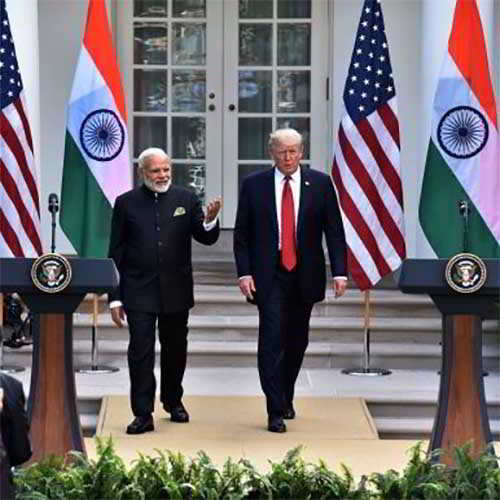
China has become the world's largest industrial producer and trading power China is the world's largest manufacturing economy and exporter of goods. It is also the world's fastest-growing consumer market and second-largest importer of goods and plays a prominent role in international trade. Sources said, about 200 American companies are seeking to move their manufacturing base from China to India post the general elections, which is now over.
The US-India Strategic and Partnership Forum's (USISPF) President Mukesh Aghi said that the companies are talking to them about how to set up an alternative to China by investing in India. The recommendation of USISPF's to the Modi government would be to accelerate the reforms and bring transparency in the decision-making process. With this Indian companies having more access to the US market, and issues like GSP would diminish. The firms have been making queries on how to set up an alternative to China by investing in India.
China holds the largest foreign exchange reserves in the world is $3.073 trillion, whereas it was $3.14 trillion in 2017.At the same time China is contributing more than any other country to global growth. It is a global power with all the bells and whistles required. China’s aid budget is the largest in the world. For example, Xinhua, its state news agency, has 180 bureaus, making it the world’s 4th largest behind the Associated Press, Reuters and Agency France-Presse. Its trillion dollar belt and road initiative is more than 10 times larger than America’s post war Marshal plan in present dollar valuation and it has the world’s largest co-existent public and private sector.
The US accuses China of practicing “state capitalism” and supporting state owned enterprises at the expense of the free market. But honestly, even in the US the government has never ceased to intervene. The US government rightly fostered the growth of the internet, bio-technology and shale gas. Likewise, during the grave financial crisis of 2008, the US rescued banks and provided fiscal stimulus. State owned enterprises are present across the developed world including in the US especially in capital intensive sectors viz infrastructure, public services and scientific and technological research.
China’s economic miracle in the private sector and contributes more than 50 percent of China’s tax revenue, 60 percent of gross domestic product, 70 percent of technological innovation and 90 percent of new jobs and businesses. Chinese private businesses and companies with foreign investors accounted for 83.7 per cent of imports and exports in 2017, up from 57.5 per cent in 2001. This is the main cause of tuff trade war among US and China.
Technology is a key underlying issue as the two countries fight for dominance in new economic frontiers such as artificial intelligence, self-driving cars and big data. It is in this sector where the biggest fault lines in the U.S.-China bilateral relationship are starting to appear.
In the recent G20 summit in Osaka, Donald Trump met President Xi Jinping. But no one is under any illusion that one of the biggest trade wars that the world has seen in recent years is on. The US has imposed tariffs on $250 billion of imports from China. Beijing has retaliated in like measure.
The US had a $375 billion trade deficit in 2017 vis a vis China. It is unsustainable. Trade flows aside, the US needs to challenge China’s rise comprehensively including but not limited to economic muscle, foreign aid, soft power and diplomacy. China is also one of America’s biggest creditors.
China’s cutting-edge technologies are also more applicable in third world markets. Financial technology, or “fintech. China’s leading fintech firms offer the means to bring millions into the financial system and provide instant loans to spur small businesses and drive growth.
There are growing calls to examine whether foreign banking networks should be allowed to connect with that of the United States if they are using Chinese technology. With the adoption of 5G standards bringing the internet more fully into all aspects of modern life, fears of Chinese spying will only increase.
The strategy would be First, restrain and challenge China’s technological growth. Stop intellectual property or technology transfer. This could be the reason why Huawei was deemed to be a ‘national emergency’ for the US. China has made huge advances in certain areas - artificial intelligence, material science, avionics and military technologies. Secondly, to reduce US economic dependence on China. Transfer investments and manufacturing elsewhere into Asia. Growing partnerships with key allies such as Japan, South Korea, Vietnam and the Philippines is to act as a counterweight. Resulting , critical to leverage India.
America -India is a natural partnership. The US-India relationship is a natural partnership between two Indo-Pacific partners. Both the countries share interests and concerns, including transnational terrorism and China's aggressive behaviour in the region and around the world. America is rebuilding and reforming our military to deter these adversaries and reassure friends like India, but more can be done.
McKinsey analysis finds that rising demand in India, together with the multinationals’ desire to diversify their production to include low-cost plants in countries other than China, could together help India’s manufacturing sector to grow sixfold by 2025, to $1 trillion, while creating up to 90 million domestic jobs.
See What’s Next in Tech With the Fast Forward Newsletter
Tweets From @varindiamag
Nothing to see here - yet
When they Tweet, their Tweets will show up here.





























